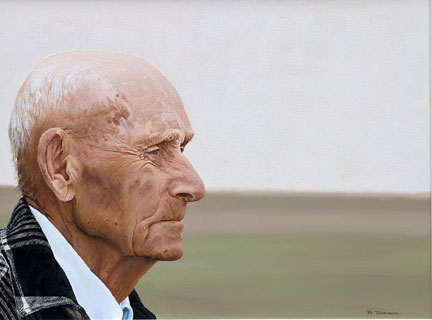As Others See Us
A figurative painting tends to be a representation of an unidentified person, a generalized image of the human form, often that of a model. A portrait is a likeness of a particular individual, an attempt in part to capture or conjure his/her being. Since the advent of photography, portrait painting has slowly been relegated to […]

The Acadian, 2005, by Brian Rossignol. Courtesy of the artist
A figurative painting tends to be a representation of an unidentified person, a generalized image of the human form, often that of a model. A portrait is a likeness of a particular individual, an attempt in part to capture or conjure his/her being. Since the advent of photography, portrait painting has slowly been relegated to the status of a minor, rearguard art, reserved mainly for commemorative or celebratory pictures of politicians, corporate big wigs, college presidents, and the families of the wealthy.
There are, however, a handful of major figurative artists who still create legitimate contemporary portraits. Chuck Close and Alex Katz, both of whom primarily portray fellow denizens of the New York art demimonde they inhabit, come first to mind. Among the younger generation there are Elizabeth Peyton (see July 16, 2008 posting) and perhaps Shepard Fairey, the skateboarding street artist whose ubiquitous HOPE portrait of Barack Obama was recently acquired by the National Portrait Gallery. (Fairey has a show opening at the Institute of Contemporary Art in Boston in February, about which more in good time).
Currently, (through February 22) the Brattleboro Museum and Art Center in Brattleboro, Vermont, is featuring As Others See Us: The Contemporary Portrait, an exhibition of portraits in a wide variety of media and styles by 75 artists. As Others See Us is the centerpiece of a winter schedule devoted to diverse manifestations of portraiture and self-portraiture.
The title of the exhibition is somewhat misleading in that the portraits show not how the artists “see” their subjects but how they “portray” them. It’s a subtle distinction but worth making. The look of a portrait is not a matter of vision, it is a matter of aesthetic choice.
The aforementioned Chuck Close and Alex Katz, for instance, portray all their subjects the same. Close translates people into his patented vocabulary derived from photorealism, breaking the physiognomy down into pixel-like tiles. Katz visits his 1960s Pop Art style of flatness informed by a 1950s hipster’s sense of Cool on everyone he paints. Both masters are included in the Brattleboro show and Close is accorded an ancillary show of his soft ground etchings (previously discussed in the July 10, 2008, posting when the 2000 portfolio was exhibited at the Colby College Museum of Art).
The many faces at the Brattleboro Museum, gathered by a consortium of curators, run the gamut from folk art-inspired family portraits by Lucy Fradkin to friezes of digital passport photographs by Sarah Wentworth. Sigmund Abeles, a powerful figurative artist I got to know when he was living, working, and teaching in New Hampshire, contributes a beautifully disturbing work entitled “Portrait of a Parasomniac,” a pastel self-portrait as a patient being treated (or is it tortured?) by medical technologies.
I would also recommend Cicely Aikman’s Matisse-an portrait of “Molly,” Xi Chai’s doll-like cartoon “My Mother,” the great Alice Neel’s “Ginny in Striped Shirt,” and German artist Thomas Bayrle’s silkscreen portrait of Stalin. Bayrle has a background as a typesetter and weaver, which may explain his penchant for constructing one image out of many.
As Others See Us is supplemented not only by the Chuck Close print show but also by an exhibition of photographs of “Injured Soldiers and Marines” by Timothy Greenfield-Sanders, San Francisco artist Christopher Irion’s “PhotoBooth” project, the Face Book-inspired “Network” portraits of Boston artist Dana Clancy, and a studio set up in the Activity Gallery where visitors can create their own portraits and self-portraits. Get the picture?
Brattleboro Museum & Art Center, 10 Vernon St., Brattleboro VT, 802-257-0124.
Edgar Allen Beem
Take a look at art in New England with Edgar Allen Beem. He’s been art critic for the Portland Independent, art critic and feature writer for Maine Times, and now is a freelance writer for Yankee, Down East, Boston Globe Magazine, The Forecaster, and Photo District News. He’s the author of Maine Art Now (1990) and Maine: The Spirit of America (2000).
More by Edgar Allen Beem

